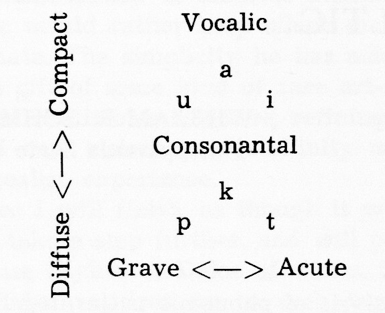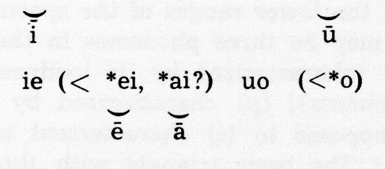Editor of this issue: Antanas Klimas
Copyright © 1967 LITUANUS Foundation, Inc.

|
LITUANUS
LITHUANIAN
QUARTERLY JOURNAL OF ARTS AND SCIENCES
Volume 13, No.1 - Spring 1967
Editor of this issue: Antanas Klimas ISSN 0024-5089
Copyright © 1967 LITUANUS Foundation, Inc. |

|
THE VOCALIC DISTINCTIVE FEATURES OF PRIMITIVE EAST BALTIC
WILLIAM R. SCHMALSTIEG
Pennsylvania State University
In their analysis of phonemic patterning Roman Ja-kobson and Morris Halle establish stages of the development in the language of the child.1 The initial stage contains the contrast between (p) and (a) which represent polar configurations of the vocal tract. Thus for (p) the tract is closed at the end, whereas in (a) the tract is at its most open position. This establishes the elementary frame for the phonemes, viz. the syllable. Next there may appear the opposition of nasal versus oral consonant, although this step is not essential. Following this there is a split between two types of consonants, the dental and the labial consonant, the dental being characterized acoustically as acute (i. e. with a concentration of energy in the upper ranges of the spectrum) as opposed to the labial which is grave (i. e. with a concentration of energy in the lower ranges of the spectrum). At this point there may be three phonemes in the system, the compact (a) (characterized by its loudness as opposed to the consonants), (p) characterized by low tonality (grave) as opposed to (t) characterized by high tonality (acute).2 The basic triangle with three phonemes hen splits into two basic triangles, one consonantal and one vocalic:

The traditional articulatory term corresponding to compact is open or low, whereas a diffuse vowel is high or narrow. For the vowels grave corresponds to back and acute to front.
Thus tongue height and tongue advancement are two of the elementary attributes of the vocalic contrast, with tongue height playing a more central or primary role than tongue advancement. As Hockett points out, "All known vowel systems involve contrasts of tongue height. In Adyge this is the only functioning contrast: there are three vowels, one high, one mid, one low."3
Traditionally the Primitive East Baltic vocalic system is diagrammed in the following manner:

[Additional diphthongs: (ai, ei, au, ui)]
Judging by contemporary Lithuanian we might suppose that the short (e) and (a) may have been slightly lower than the long counterparts, but the distinction would have been allophonic rather than phonemic since the basic contrast was one of length rather than tongue height.
It is easy then to divide the long vowels up (phone-mically) into a succession of two short vowels: (î) = (ii); (û) = (uu); (â) = (aa); (ç) = (ee). The dipththongs can also be divided up into their constituent elements. Thus (ie) = (i) plus (e). Whatever the second element of (uo) may have been phonetically it can be classed phonemically with (a) so (uo) = (u) plus (a). Likewise (ai) = (a) plus (i); (ei) = (e) plus (i); (au) = (a) plus (u); (ui) = (u) plus (i). Therefore the Primitive East Baltic vocalic system had only four vowels:
(i) (u)
(e) (a)
The diphthongization which created (ie) and (ua) (traditionally uo) was merely a simplification of the system reducing it to the two most elementary vocalic contrasts, viz. tongue height and tongue advancement or in acoustic terms, compact vs. diffuse and grave vs. acute.
Compact Grave
(open, low) (back)
(i) -
-
(e) +
-
(a) +
+
(u)
- +
We may now note another interesting characteristic of the diphthongs and the two-element or long vowels, namely the fact that folowing an acute vowel [i. e. the front vowels (i) and (e)] no grave vowel is admissible. The sequences (ii, ie, ei, ee) are possible, but not *(iu, ia, eu, ea); thus the contrast between grave and acute (back and front) is neutralized here. This neutralization shows the grave/acute contrast to be of secondary importance in contradistinction to the compact/diffuse contrast. Following a grave vowel [i. e. the back vowels (u) and (a)] the grave/acute contrast is possible for the diffuse (i) and (u), but not for the compact (e) and (a). In other words the following sequences are admissible: (aa, au, ai, ua, uu, ui) but not *(ae, ue). This again shows the grave/acute contrast to play a less important role than the compact/diffuse contrast. It is also interesting to note that this contrast between grave (back) and acute (front) appears in the diffuse (high, narrow) vowels, precisely where there is more articulatory room for such a contrast than in the compact (open, low) vowels.
It is generally accepted that following a consonant and before a front vowel the phoneme (j) was lost in Primitive East Baltic.4 Thus the sequences *(Cje) and (Ce) were merged as (Ce) and the sequences *(Cji) and (Ci) were merged as (Ci). This means then that the sequences *(Cje) and *(Cji) no longer existed; a con-sequense or the inadmissibility of *(Cje) and *(Cji) is the fact that following *(Cj) only the grave (back) vowels (a) and (u> were possible.
Thus the contrast of acute (front) vs. grave (back) vowels is neutralized and only the contrast of compact (low) vs. diffuse (high) vowels is possible in position following (Cj).
In conclusion then, one can say that
Primitive East Baltic illustrated the primacy of the compact/diffuse
(low vs. high) vocalic contrast over the grave/acute (front vs. back).
The compact/diffuse contrast is never neutralized, but the grave/acute
contrast is neutralized in numerous positions. The feature of
lip-rounding vs. lack of lip rounding is purely redundant.